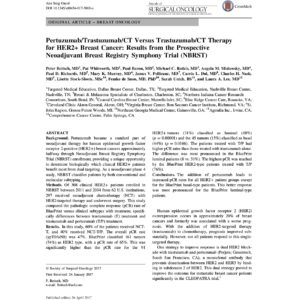PUBLICATION: 
Ann Surg Oncol. 2017 Sep;24(9):2539-2546. doi: 10.1245/s10434-017-5863-x.
AUTHORS:
Peter Beitsch, MD; Pat Whitworth, MD; Paul Baron, MD; Michael C. Rotkis, MD; Angela M. Mislowsky, MD; Paul D. Richards, MD; Mary K. Murray, MD; James V. Pellicane, MD; Carrie L. Dul, MD; Charles H. Nash, MD; Lisette Stork-Sloots, MSc; Femke de Snoo, MD, PhD; Sarah Untch, BS; and Laura A. Lee, MD
ABSTRACT:
Importance: Pertuzumab became a standard part of neoadjuvant therapy for human epidermal growth factor receptor 2-positive (HER2+) breast cancers approximately halfway through Neoadjuvant Breast Registry Symphony Trial (NBRST) enrollment, providing a unique opportunity to determine biologically which clinical HER2+ patients benefit most from dual targeting. As a neoadjuvant phase 4 study, NBRST classifies patients by both conventional and molecular subtyping.
Methods: Of 308 clinical HER2+ patients enrolled in NBRST between 2011 and 2014 from 62 U.S. institutions, 297 received neoadjuvant chemotherapy (NCT) with HER2-targeted therapy and underwent surgery. This study compared the pathologic complete response (pCR) rate of BluePrint versus clinical subtypes with treatment, specifically differences between trastuzumab (T) treatment and trastuzumab and pertuzumab (T/P) treatment.
Results: In this study, 60% of the patients received NCT-T, and 40% received NCT-T/P. The overall pCR rate (ypT0/isN0) was 47%. BluePrint classified 161 tumors (54%) as HER2 type, with a pCR rate of 65%. This was significantly higher than the pCR rate for the 91 HER2+ tumors (31%) classified as luminal (18%) (p = 0.00001) and the 45 tumors (15%) classified as basal (44%) (p = 0.0166). The patients treated with T/P had higher pCR rates than those treated with trastuzumab alone. The difference was most pronounced in the BluePrint luminal patients (8 vs. 31%). The highest pCR was reached by the BluePrint HER2-type patients treated with T/P (76%).
Read more: Pertuzumab/Trastuzumab/CT_Beitsch et al_Ann Surg Oncol_2017

